Bernie Taupin, Elton John lyricist, is a True American artist

He’s one of the most acclaimed and successful British songwriters of all time, but in his heart Bernie Taupin is a true American.
Taupin, known for generations the world over as Elton John’s lyricist, has worked as a visual artist for decades. His latest body of work, the exhibition “True American” on display through Nov. 10 at Chase Contemporary in Manhattan, finds Taupin re-purposing elements of Americana imagery — particularly American flags and weathered instruments — continuing a thematically consistent, lifelong artistic pursuit.
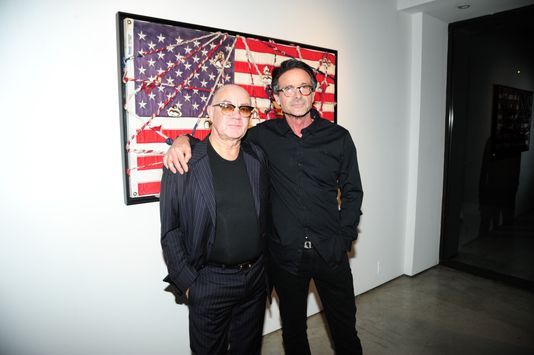
“I can tell you from my perspective that I’m absolutely thrilled with this show,” Taupin said when calling from the gallery. “It’s without a doubt certainly the most cohesive and certainly for me the most satisfying show I’ve ever put together.
“I think there is, as I said, a cohesiveness that is quite special, certainly for me anyway. There’s always a magic to seeing the materials that are sort of lying around in your studio suddenly, magically, placed upon walls, symmetrically and well-lit, that is very invigorating for the artist.”
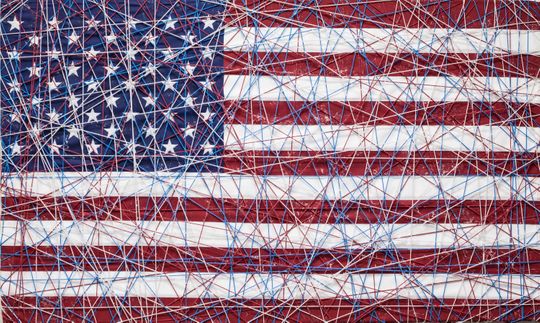
Taupin recently discussed the complex iconography of the American flag, the artistic merits of appropriation and more with the Asbury Park Press and USA Today Network.
Q: Talking about the cohesive nature of this exhibition, which I can see from just thumbing through the catalog, was there a guiding vision or North Start of sorts as you were assembling the pieces that would form “True American”?
A: Well, I don’t know if this is necessarily the answer that you want but I think that as an artist — an artist, I should say, on any level, whether it’s musical, whether you’re writing a book or whether you’re writing poetry or creating songs — I think we all start by poaching a little, but our ultimate goal is to find our own voice. And I think that’s really the crux of the situation here with my work, especially with the flag-based material that is the emphasis of the show and the what I call “web and weaving” style that I use.
I think all of these things I’ve pretty much reached a point where I’ve reached a sort of originality of my own whereas in the past, in the early years, as I said we poach off other artists, not necessarily flagrantly but they sort of soak into our bloodline and they do sort of tend to infuse us with something that we try to emulate. But at the same time, I think there is that drive to create something that you feel is your own voice.
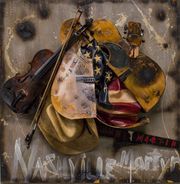
And I think it’s taken me a long time, but I think with this exhibition and certainly the flag emphasis, which is the central point of most of my work these days along with the sort of organic instrumental addition to it and the blending of the two, I think I’ve created something that is pretty special — special to me anyway, and hopefully it’ll be special to other people and they will hopefully see the originality in it. I suppose that’s it in a nutshell, yes.
Q: That’s interesting, the concept of poaching. It brings to mind a theme that sometimes is addressed quite literally in the work but it’s also thematically present, and that’s the concept of appropriation, taking found objects and constructing new art of them, whether that’s a flag or newsprint or twine.
But it’s also thematic and cultural acts of appropriation in the way you’ve weaved in elements of Americana and American history and American culture. I find that to be a fascinating theme running through your work, this concept of appropriation.
A: There’s lots of different answers to that. The appropriation of found materials has been ongoing in my work for a long time. You can drive down the road and see something lying on the side of the road that’s probably as insignificant as a piece of coiled, rusting barbed wire but to me that’s a priceless jewel because I know that somewhere within the framework of my work I can certainly use that, and I’ve used that.
But certainly the thing about the flag that is so unique to me is that’s so malleable and misunderstood at the same time. The interesting thing about the flag to me is there is so much discussion about misusing or mishandling of the flag.
The one thing that I find fascinating (is) that if you actually look into the rules of flag disposal when it needs to be replaced with something new one of the key components of disposing of a flag is burning it in a respectful way, which is kind of odd considering that disrespect of the flag is people burning it, too. So my feeling is what I’m doing with it is from a totally respectful viewpoint.
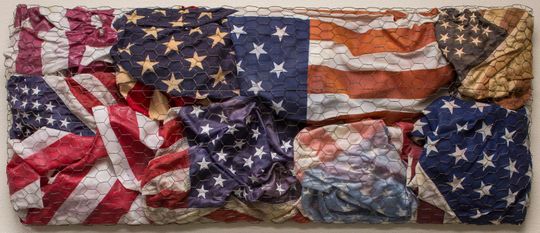
But as I say, the flag is so wonderful because it’s so malleable and in my work I can use it in so many different ways and hopefully that’s what I’ve done, whether it’s intertwined with battered musical instruments that come from a very American standpoint also; I mean, all of my musical pieces that involve the flag are created with a sense of a genre that is wholly American, whether it’s blues or traditional gospel or traditional country music, I think the flag represents itself within that framework tremendously because it’s wholly American.
That’s how I sort of view my work in general: it all comes from a gut level, organic, American viewpoint.
Q: Flag imagery, what some consider patriotic imagery, is very potent and very provocative, especially these days when there are folks who choose to metaphorically wrap themselves in the American flag to support whatever sociopolitical or personal or ideological viewpoint they have.
It’s a very loaded image as well, especially in 2018 in America. It’s a very striking primary color image but it’s also a totem that has a lot of weight to it depending on who’s using it and how.
A: You’re absolutely right. There are so many different viewpoints where the flag is concerned. I mean, there are people obviously that don’t respect it with any particular value or don’t associate to it with any particular value.
What I find extraordinary about the American flag is I don’t think there is any other country in the world, and I don’t think you can name one, where the flag is as iconic as it is in this country. I wrote a piece for the Callanwolde (Fine Arts Center) catalog that we did for Atlanta, and in it I was saying that I live in a very, very small town on the central coast of California and you can stand in my gas station, which is a mom and pop gas station, you can look up and down the road, and I would say you can see probably 12 to 13 flags flying above, whether it’s private homes or whether it’s the gas station or the grocery store.
I don’t think there is any other place in the world that you could experience that same situation. So the flag here is certainly the most iconic flag in the world, I mean it’s the most recognizable. And again, for me I take the flag and I use it with the greatest respect and I am very, very patriotic.
This country is very important to me, I’ve lived here for over half of my life, I’ve been a citizen here for over half of my life, and so it’s a symbol that speaks volumes to me. I never tire of working with it. I will probably move on to other forms of artwork but I don’t see a point in time where I will stop using it to some degree in the things that I create.
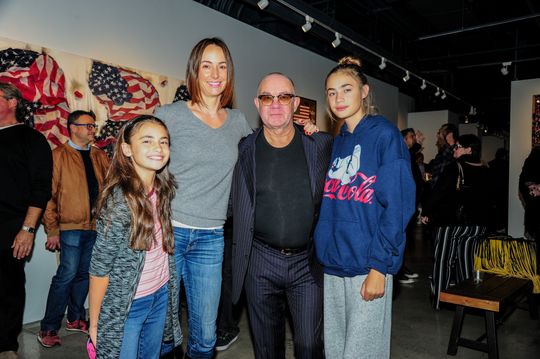
This article was originally published by app.